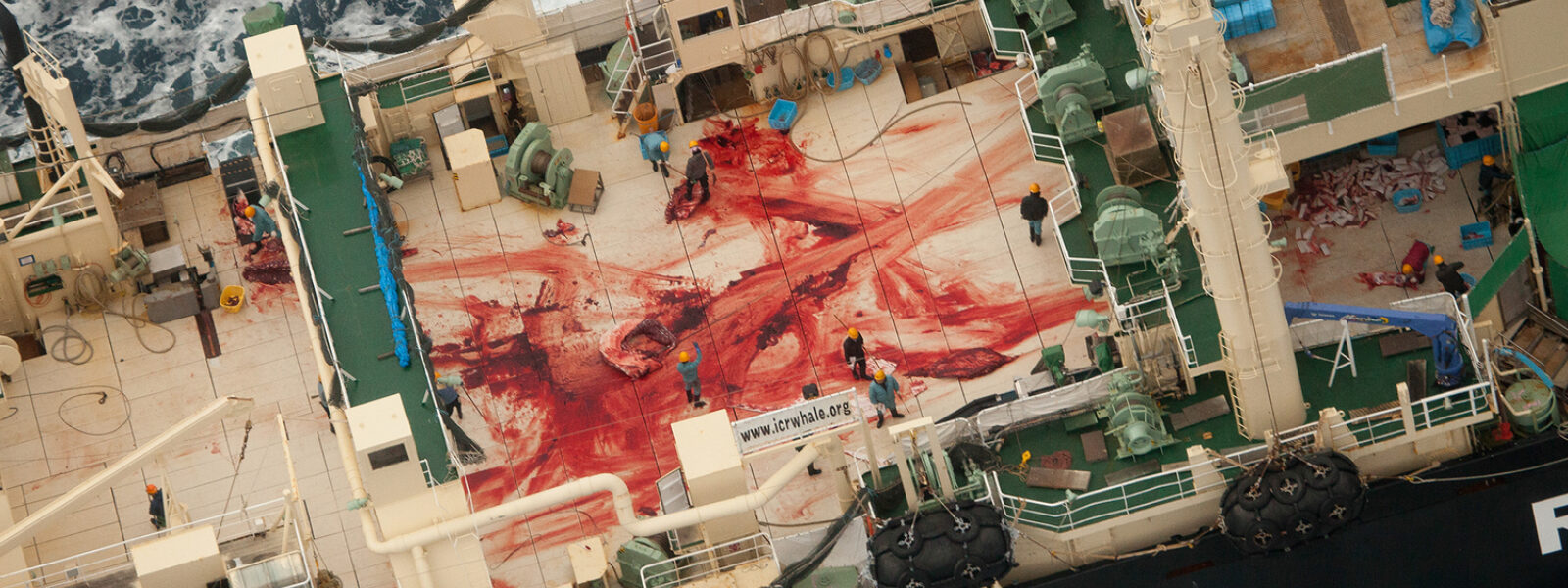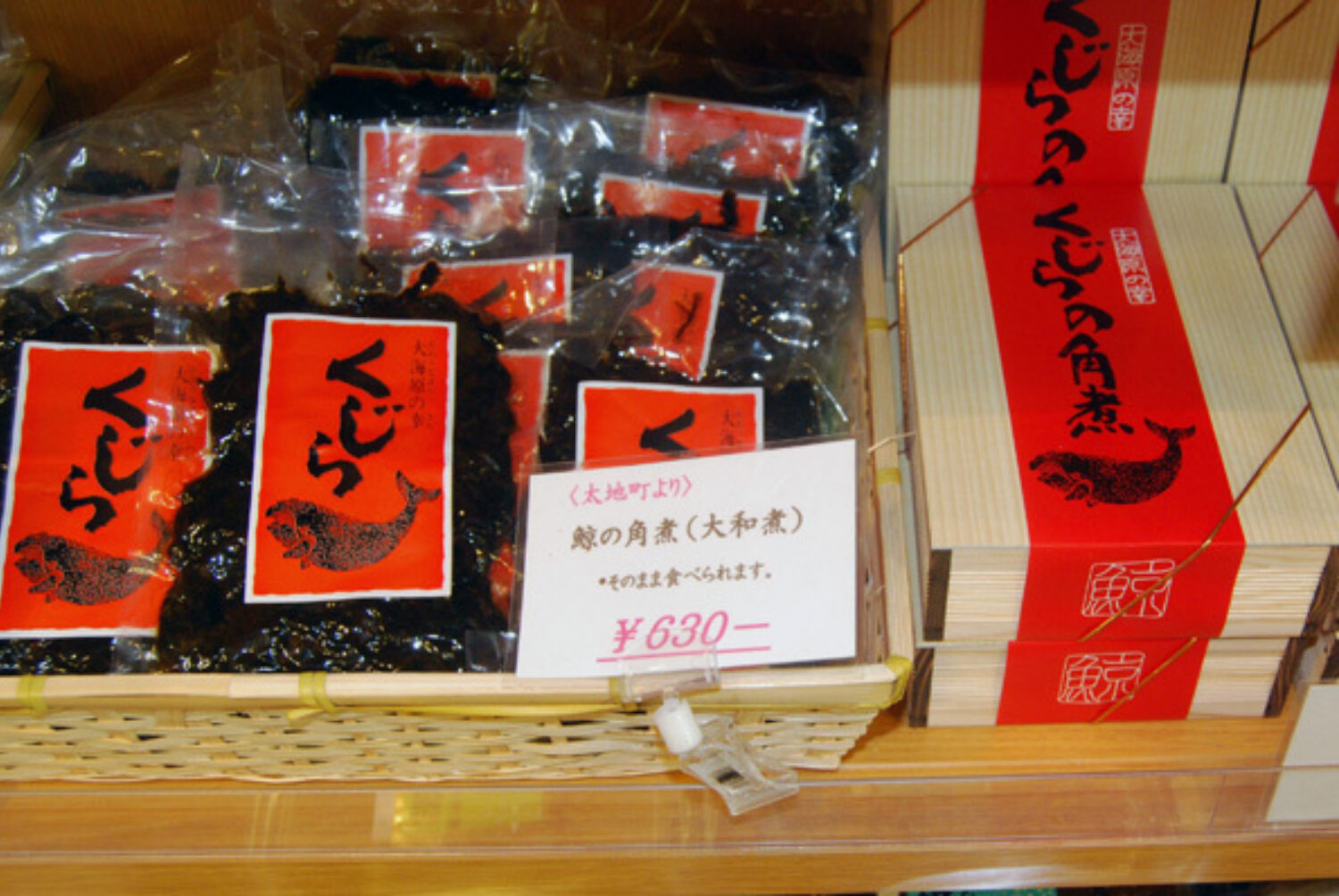
Japan’s Whaling Ships Kill 212 Whales
Photo Credit: Sea Shepherd Conservation Society
By Mark J. Palmer
Japan’s government announced that the aging whaling mothership, the Nisshin Maru, has returned from its annual whaling voyage in Japanese waters to its homeport of Shimonoseki with the carcasses of 187 Bryde’s whales and 25 sei whales. The sei whale is listed on the International Union for the Conservation of Nature’s (IUCN) red list as Endangered.
The whaling voyage lasted from June 15th through November 8th, and was confined to Japan’s 200-mile Exclusive Economic Zone (EEZ). The Nisshin Maru was accompanied by one much smaller catcher boat.
The next step in the process, a daunting one, is to convince its citizens to buy the stuff and eat it. Whale meat is not popular in Japan, which has ready access to other meats and seafood. The Japanese government and whaling industry repeatedly try various stunts to encourage the buying of whale meat, with little to show for it.
In the aftermath of the destruction of World War II, Japanese residents were starving and had no ready sources of protein. The US occupation army encouraged the building of a whaling fleet to obtain whale meat. Numerous Japanese students grew up in the post-war era having whale meat for school lunch. For many, this was not very pleasant, although there are others who learned to like whale meat. They represent a dwindling number of aging Japanese who are now the main market for whale meat.
Young people in Japan generally avoid whale meat. Repeated polls have shown that only a small percentage of Japanese have eaten whale meat or plan to buy whale meat.
Ordinarily, whale meat is frozen on board the Nissan Maru. But 1.4 tons of sei whale meat was not frozen on the whaling ship this year. This fresh, unfrozen meat was to be auctioned off on Nov. 16th at the local wholesale market, with promoters hyping the unfrozen meat as even better tasting than frozen whale meat. As noted, whaling entrepreneurs are trying all kinds of stunts.
Some whale meat is ending up in pet food and dried as jerky. And some simply stored frozen in warehouses waiting for a sale.
The Japanese government left the International Whaling Commission in July 2020, after repeated fruitless attempts to overturn the 1986 IWC moratorium on commercial whaling. During the interim years, Japan had conducted what was called “research” whaling under scientific permit. Despite resolutions by the IWC and a World Court decision condemning the phony scientific whaling scheme, Japan persisted in killing hundreds of whales annually.

Whale meat, sold in a store in Taiji, Japan. Photo Credit: Mark J. Palmer
However, while Japan whalers can now hunt whales in Japan’s territorial waters and no longer need the cover of “research”, they cannot enter international waters, as the Law of the Sea Treaty prohibits whaling by countries that are not members of the IWC.
Nonetheless, the Japanese government continues to push whaling as some kind of special necessity for the country. In past years, the government subsidized whaling operations with 5.1 million yen ($48 million) annually, but recently conservatives have pushed the industry to be self-supporting, a very unlikely scenario under current conditions.
Furthermore, the factory ship Nisshin Maru is showing its age. Built in 1987, the ship has been battered by the heavy seas of Antarctica for years. A new vessel is needed, especially if the industry is to go back to whaling in the waters of Antarctica, a whale sanctuary designated by the IWC. Japan does not recognize the sanctuary. But the cost of a new mothership will be very high, with no guarantee that its capacity can be used.
Recently, the Japan government set quotas for next year's whaling season, basically repeating last year's (and the year before that) quota: 383 whales total, which includes 25 sei whales, 187 Bryde’s whales, and 137 minke whales. The quota also includes 34 minke whales that will be caught as “bycatch” in fishing nets -- death by drowning as opposed to an explosive harpoon.
As noted above, sei whales are on the IUCN's endangered species list. Some stocks of the minke whales near Japan are considered depleted by the IWC Scientific Committee. But like the governments of Norway and Iceland, Japan’s government makes up its own whale population numbers to justify whaling.
*******************
The International Marine Mammal Project of Earth Island Institute is seeking an end to whaling and dolphin killing promoted by Japan’s government.
Why are the Japanese people being taxed to subsidize the killing of whales when few of them will ever bother to eat whale meat? Some whales and dolphins are highly contaminated with mercury and other pollutants, which is ignored by health and government agencies in Japan. Again, we ask: Why?
Ending Japan’s whaling will benefit the whales and the health and wellbeing of the Japanese people.
What You Can Do:
Your donations are what keep the International Marine Mammal Project on target to end the cruelty of whaling, captivity, and dolphin hunts around the world. Please contribute to help save dolphins and whales. Thank you!
